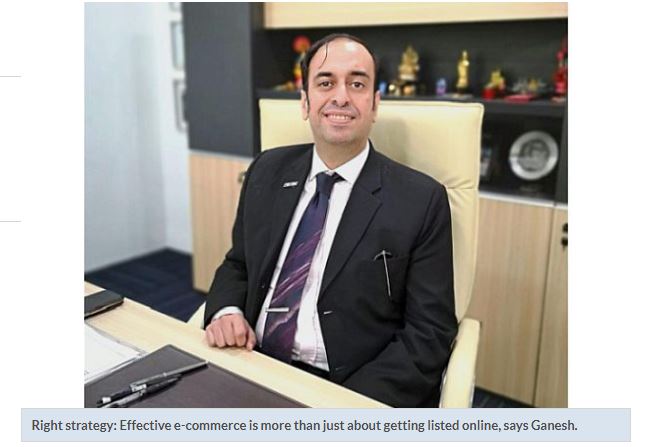Malaysia: Maximise e-commerce opportunities
THERE is an ongoing drive to push small and medium-sized enterprises (SMEs) to go digital to tap a bigger market. But moving online is a lot more than just uploading a product catalogue onto a webstore or marketplace.
Businesses need to also know how to effectively sell their products online.
And given the low entry barrier to e-commerce, there is a greater need for businesses to find their niche in the vast and competitive world of the Internet.
“It’s called finding your product-market fit,” says Commerce DotAsia Ventures Sdn Bhd executive chairman Ganesh Kumar Bangah.
Ganesh likens the process of setting up an online store to that of setting up a physical shop. Business owners still need to consider their product mix, target customers, brand proposition, product messaging and market feedback.
This requires SMEs to be more market savvy than technology savvy.
“Local SMEs lack the knowledge of finding product-market fit. Our entrepreneurs think that they only need to put all their products online and their customers will come and buy. That’s not the case.
“When the tools to sell online are becoming commoditised, the challenge of selling online is no longer technology. The challenge of selling online is actually market. They need the right skillset and capacity development for that,” he adds.
The process of finding the right product-market fit is market discovery, market messaging, market outreach and market feedback. Entrepreneurs need to know who their customers are and what they want, how to properly position their products and how to correctly reach their customers, he elaborates.
This is necessary to help them grow their online business.
But it’s not all online. Ganesh advocates an omni-channel strategy to be more effective.
“Traditional channels will still exist. They are just different channels for you to buy products and the difference is the experience. Online channels are more convenient but you don’t get the experience. Offline channels are not as convenient but you get the experience. So you need both channels.
“I don’t think you should differentiate what you push through the channels. It’s not about what you put on these channels but what you prioritise on them. The biggest mistake we see among retailers is that they think about offline and online as two different things.
“But you should get those who are buying offline to start going online, because they’ve already had the experience,” he says.
It is important that SMEs are equipped to fully tap into the opportunities that e-commerce has to offer as they make up an important component in the local economy.
According to reports, e-commerce across the region is expected to grow from US$10bil (RM41bil) this year to US$88bil (RM362bil) by 2025.
As it stands, only over 20% of local SMEs have online presence.
“SMEs are not catching up in tandem with consumers’ adoption of e-commerce. When consumer adoption is faster than SME adoption, what happens is our local buyers will be buying more cross-border from foreign merchants,” Ganesh says.
“SMEs want to sell online but they don’t know how. Capacity building is what the country needs for our SMEs. We take too much for granted by just trying to put everything on marketplaces,” he adds.
He opines that the government should promote linkages between enablers to service the SMEs, and encourage capacity building through funding and incentives.
He also hopes that there would be a more focused strategy to get our SMEs online and to build more quality SMEs overall.
“They are not focused enough, especially when it comes to e-commerce. The government is talking about Industrial Revolution 4.0 (IR4). IR4 is to manufacturing the same way e-commerce is to trading and retail. So we are pushing capacity development for IR4 but we are not pushing capacity development for e-commerce, which means we are building capacity for production but not for distribution.
“But we are a trading nation. And with the Digital Free Trade Zone, we are going to get an influx of foreign products and merchants. If we don’t train our local merchants to increase their capacity fast enough, there will be a huge issue,” he says.
Malaysia has the potential to be the e-commerce hub of South-East Asia. But if we do not increase our capacity, the country may likely end up becoming a port for products to come in and out.
“And we won’t get to be the place where our locally manufactured products actually get to go out. So e-commerce enablement is an integral part of IR4,” he adds.
About a year ago, Ganesh saw the need to equip local small businesses with a growth mindset that will help them have better reach.
Under Commerce.Asia, he licensed the GrowthX academy and accelerator programme from Silicon Valley for the region. It will launch its first branch in Malaysia sometime this month with a 5,000 sq ft facility in Kuala Lumpur.
The academy teaches three course skills: growth marketing, user experience, as well as sales and business development.
It is also targeting corporates that intend to send their talents for training.
“When SMEs sell online, their two biggest problems are confusion and knowledge. They don’t know how and they are confused because there are so many things they need to do. So they either train themselves through an academy like this or they can engage a managed service provider like Commerce.Asia, for example,” Ganesh says.
Source: https://www.thestar.com.my/business/smebiz/2018/09/03/maximise-ecommerce-opportunities/#lgROJlf3oO8yqgIq.99


 Thailand
Thailand




